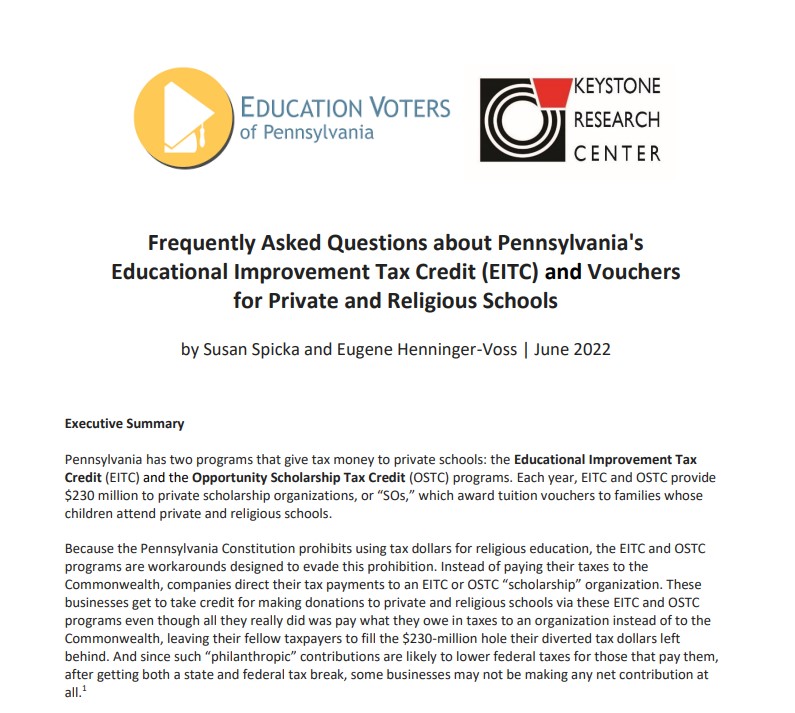Since 2001, Pennsylvania has spent more than $2 billion on school vouchers for private and religious schools through the Educational Improvement Tax Credit (EITC) and Opportunity Scholarship Tax Credit (OSTC) voucher programs.
By any standards, $2 billion is a lot of money. One would imagine that Pennsylvania lawmakers would want to know if this money had been put to good use and helped to improve educational outcomes for Pennsylvania students.
Alas, the Pennsylvania legislature has shown NO interest in learning who has benefitted from $2 billion in tax money spent on vouchers or what impact it has had on student learning outcomes. Instead, state lawmakers have voted for a 17x increase in funding for EITC/OSTC vouchers over the past 20 years with NO corresponding increases in fiscal or academic accountability.
There has been a lot of chatter about implementing a new voucher program in Pennsylvania in 2023.
It would be wildly irresponsible for state lawmakers or Governor-elect Shapiro to entertain any conversations about expanding school vouchers without first conducting a thorough examination of Pennsylvania’s existing EITC/OSTC voucher programs.
Any policy discussions to increase funding for school vouchers must be based on data that will demonstrate that Pennsylvanians’ taxpayer dollars will help improve educational outcomes for Pennsylvania students.
What we know about Pennsylvania’s EITC/OSTC school voucher programs.
✅ Families have benefited from taxpayers subsidizing their private school tuition payments.
✅ Private and religious schools have benefitted from receiving tax dollars.
✅ Scholarship organizations have benefited from being allowed to keep 20% of the EITC/OSTC funding they receive.
What we DON’T know about Pennsylvania’s EITC/OSTC school voucher programs.
❌ Did voucher students experience a positive or negative impact on their academic achievement?
❌ How many voucher students were attending a private school before they received a voucher?
❌ How many low-income students have used vouchers?
❌ How many families that received vouchers exceeded the income limit set by the program?
❌ How many students were unable to use vouchers because private and religious schools discriminated against them and refused to admit them?
❌ How did scholarship organizations spend the hundreds of millions of tax dollars they received through the EITC/OSTC programs that were not spent on vouchers for students?
Our report
We did a deep dive into the EITC/OSTC programs and found that Pennsylvania law explicitly prohibits the collection of the information that would be necessary to evaluate the programs. In fact, a January 2022 report from the Independent Fiscal Office concluded that “subsidized tuition clearly increases opportunities that may not otherwise be available to certain students, but it is not possible to comment on whether state funds have been used effectively due to lack of general and specific outcome data.”
Read our report to learn about the EITC/OSTC voucher programs HERE.

Since we know nothing about who benefits from vouchers or the impact that vouchers have on student achievement in Pennsylvania, it is helpful to look to other states that actually collect this data. Michigan State professor, Josh Cowen, has recently shared data that should raise red flags for Pennsylvania lawmakers who are pushing for an expansion of vouchers in the commonwealth.
Cowen found that large independent studies of voucher programs in Washington, DC, Indiana, Louisiana, and Ohio paint a grim picture of the effectiveness of vouchers in terms of student outcomes. Data from these studies show that students who left public schools to attend private and religious schools using vouchers experienced negative impacts on their academic achievement.

In states that do report the data—Arizona, New Hampshire, and Wisconsin—more than 75% of voucher applicants were attending private schools before they received a voucher. The vouchers these students received did not create new opportunities for students; instead, they were simply taxpayer-funded subsidies for tuition that families were already paying and could afford.

School vouchers—taxpayer-funded assistance that pays for students’ private school tuition—undermine the commonwealth’s ability to fully fund public schools. Every dollar that is used to subsidize families’ private school tuition bills leaves fewer dollars available to be spent in the state budget. As a result, voucher programs contribute to higher local property taxes and fewer programs and services for the 90% of Pennsylvania students who attend public schools.
Pennsylvania already has a HUGE voucher program that received a $110 million increase in the 2022-2023 state budget, bringing the total to a whopping $340 million in tax money to be spent on EITC/OSTC school vouchers this year.
The ONLY voucher discussion in Harrisburg in the new year should be focused on examining Pennsylvania’s current EITC/OSTC programs to determine if $2 billion in school voucher spending has produced any benefit to the commonwealth over the past 20 years.


Recent Comments